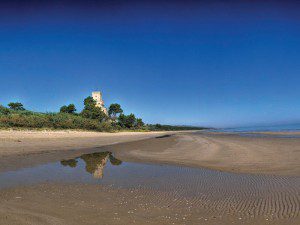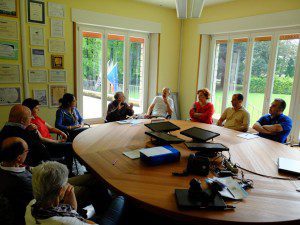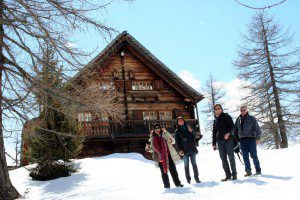INTERNSHIP POSITION Communication and IT management
The EUROPARC Federation is currently looking for a full time paid intern in its Communications department in Regensburg (DE). The intern will contribute to enhance the organisation’s outreach and communications activities and will support EUROPARC Communications with operational and administrative tasks.
The position requires strong IT skills, good organizational and multitasking abilities as well as the attention to details. The candidate must have strong writing skills – able to create and deliver messages through a variety of media channels for internal and external stakeholders – and good knowledge of digital communication tools.
The intern will have the opportunity to contribute directly to the work of a wide European environmental organisation, working along with an international team. The intern would have the chance to put into practice IT knowledge, to further develop communication skills, to learn about EUROPARC Federation and its programmes, and to discover from closer the functioning of European Protected Areas and EU environmental policies.
Download the full description and conditions.
Deadline for applications: 15th April.
The ECST in Italy: which are the reasons for success?
Pollino National Park, Italy © Stefania Petrosillo
Stefania Petrosillo, Charter Expert in Italy, in charge of the Charter for Federparchi-Europarc Italia during 2008-2015, shared her considerations about the Italian experience on the European Charter for Sustainable Tourism in Protected Areas. This post is also available in Italian.
In few years, the European Charter for Sustainable Tourism in Protected Areas has gained great importance in Italy, and it is now considered by Parks, Regions and the Ministry of the Environment a very useful tool for the governance of protected areas.
Several factors have made this success possible, and, in order to hold this very good result, it will be necessary in the next future to reinforce these elements and think carefully on some critical issues.
The evolution since 2001
In the late nineties, Alpi Maritime Regional Park decided to be one of the seven pilot areas in Europe to test a new instrument: the European Charter for Sustainable Tourism. In 2001 it became the first Charter Park in Italy, shortly followed by Sibillini National Park and Adamello Brenta Natural Park. A few years later, the Lombardia Region decided to support and to finance Charter’s application for four of its regional protected areas.
A major change occurred in 2008: Federparchi and Europarc Italia (that were, until then, two separate entities) merged to form a single association. Afterwards, the Charter became a priority working area within the Italian section that started to promote the instrument among Italian Parks, Regions and the Ministry of Environment.
Consequently, the number of parks interested in the Charter began to grow up quickly. Some Regions (Puglia and Marche) decided to follow the example of Lombardia sponsoring the Charter amongst their regional parks. In 2011, the Italian Ministry of Environment signed with Federparchi-Europarc Italia the first of a number of agreements, providing financial support for the certification of national parks and sustaining seminars and study on the Charter. In 2012, the Regional Reserve of Monte Rufeno (in Lazio) became the n. 100 Charter Park in Europe.

Marine Protected Area of Torre del Cerrano became the first Charter MPA in Europe © Parks.it
In 2013, Federparchi-Europarc Italia received the “Special Tourism Award” for its “proactive engagement in support of the Italian protected areas in the implementation of Charter”.In 2014, the Marine Protected Area of Torre del Cerrano became the first Charter MPA in Europe. In 2015 two parks (Adamello Brenta Nature Park and Regional Park Dune Costiere) certified the first sustainable partners (Charter Phase II) in Italy.
The reasons for success
Today the Italian network can count on 29 certified Areas and many others are candidates.
Why is the Charter so successful within the context of the Italian protected areas?
Firstly, it should be noted that almost all of the Italian parks are inhabited territories. For that reason, dialogue, collaboration and consensus of local communities become essential. The Italian law already requires official mechanisms for public participation. The Charter, as a volunteer certification scheme with defined scope and clear objectives, could offer them a very concrete important support. Therefore, the Charter responds to a real need felt by the Italian Park management authorities.

Dolomiti Bellunesi National Park © Stefania Petrosillo
Italy is a tourist destination of excellence. The tourism market is very important for the country, but the institutional actors involved in this sector are many and often disconnected. Precisely for this reason it is essential to develop the coordination between decision-makers, in order to favour the development without endangering the “capital” (the cultural and natural heritage). The Charter methodology could be an excellent answer for this requirement.
Furthermore, the internationality of the Charter is a very attractive element for the Italian Parks that perceive the charm and potential to receive a European-wide recognition.
Definitely, the role played by Federparchi-Europarc Italy in promoting the Charter has been a key for the success. In these years, the Section has coordinated and animated the Italian network, and spread information on Charter among parks and institutions. Moreover, protected areas receive technical assistance from Federparchi, with high-quality consultancy up to the candidature and, after being awarded, support for monitoring, training and updating.
Also the commitment of the Ministry of Environment and of the already mentioned Regions has been strategic and crucial in the growth of the number of certified areas. All this shows as the Charter in Italy has been promoted, managed and perceived as a national network program, and not just as an individual path taken by individual Parks.
One peculiarity of the Italian experience concerns the private sector: private businesses, in fact, are involved from the very beginning of the Charter journey, even in phase I. In many cases, they have proved being a strong point of Italian Charters.
Criticalities
Of course, together with so many positive aspects, there are also weaknesses and risks that should be mentioned.
First crucial aspects concern coordination, planning and real possibility to implement in five years the identified strategy and action plan. Politics changes and strategy switches characterizing so often the national, regional and local overview in Italy inevitably have a serious impact on protected areas. In some cases, it is difficult to consistently engage public authorities’ representatives (which instead are essential for the coordination of the policies on the field) in the Forum, along the five years.
In close connection with this, a really critical issue is the perennial uncertainty about the amount of public funding that will be allocated each year for protected areas.

Ossola Nature Park, Italy © Stefania Petrosillo
In some cases, an element of weakness may arise from park’s motivation, that can start the Charter journey because asked by the Ministry or the Region, or in order to receive a European diploma, but without really subscribing the Charter idea and method. Moreover, a sensitive moment occurs when a new president or director is nominated: he has to be able to fully understand and estimate the importance of the Charter process that he has not seen being developed from the beginning. In these cases, the Charter risks to be perceived just as one project among many others to be entrusted to a single official of the staff, and not as a working method to be adopted by the entire Park Authority. When this happens, Charter can lose all its value and the entire work done with the Forum may be frustrated.
Conclusions, in perspective
Looking ahead, it is crucial to encourage and support the hard work and commitment of many parks presidents, directors and officers who, despite of all difficulties, are carrying on their work with the Charter with enthusiasm and excellent results.
Dialogue between private sector and park authorities will likely increase, also through the Charter phase II. However, it is fundamental that the phase I was solid. Park authority and public bodies have to guarantee a clear stable policy framework, within privates can engage working towards an environmental management of their businesses and developing activities promoting and respecting the protected area.
The national networking is a strength of the Italian system to be preserved, also through joint projects. At the same time, it will be strategic to continue emphasizing and enhancing the European nature of the Charter, as also affirmed in the Europarc Federation Strategy 2020. Much is already being done and much will be necessary to do, in terms of European projects, promotion, technical seminars, events, lobby towards European and international institutions, involvement of private business in the European network, etc. In this sense, networking will be essential, with reciprocal commitment of the Federation, of national sections and of all Charter protected areas.
In conclusion, the Charter in Italy is an experience of great interest, to be maintained, improved and made even more visible at local, national and at the European level.
A Youth representative in the EUROPARC Council
Who will be the 1st Youth representing Europe’s Protected Areas?
To enable young people to more fully take part in the governance, management, activities and support of protected areas across Europe, the EUROPARC Federation has decided to open a new position for a youth representative within the Council.
WHO CAN APPLY: anyone aged 18 to 25, having been involved in Junior Ranger or in other volunteer work in a Protected Area member of EUROPARC and being supported by this member.
WHO WILL VOTE: The Youth representative will be elected by the 36 participants of the Youth Conference (2013) and of the Youth+ Camp (2015).
HOW TO APPLY: submit your candidature before the 4th of April 2016 through a motivation letter and a short video message.
Sustainable Biomass in protected areas
BioEuParks, Developing an efficient and sustainable biomass supply chain in 5 European Nature Parks, www.bioeuparks.eu
European Parks showcased models for sustainable biomass exploitation
On the 3rd of March, representatives from European Institutions, Protected Areas and representatives from NGOs,discussed models for wood biomass supply chains in European Parks and its contribution for local development. The Conference “Solid Biomass in European Protected Areas”, held in the Committee of the Regions (Brussels), highlighted the results of the BioEUParks project, proving that there are sustainable alternatives for local exploitation and consumption of solid biomass.
To address the European Union strive for renewable energies predicted in Horizon 2020, five Protected areas developed different models for sustainable exploitation of wood biomass in their regions, ensuring nature protection whilst bringing economic benefits for local communities. The project BioEUParks was developed during three years by protected areas in Austria, Hungary, Slovenia, Italy and Greece, with the support of other organisations related with energy, forestry and protected areas. Pioneering with a different model of solid biomass exploitation, in opposition to the large-scale plantations, partners have developed local supply chains of wood biomass, coming from sustainably managed forests and agricultural residues, and promoted the implementation ofsmall-scale boilers for heatproduction.
Roby Biwer, member of the Committee of the Regions (CoR) who hosted the Conference, opened the session stating highlighting the urge for the “new EU energy policy to recognise that there is a limited amount of sustainable biomass (…) and that biomass should always be used in the most resource and energy efficient way”. Following his idea, Miapetra Kumpula-Natri, Member of the European Parliament, mentioned biomass as an important alternative “if fossil fuels are meant to be replaced by renewable sources”, stressing also the potential of wood biomass towards developing a circular economy.
Representatives of European NGOs and from the European Commission – DG Environment, DG Agriculture and Rural Development and DG Energy also participated in the discussion highlighting the challenges and limits of biomass exploitation. On the environmental perspective, Peter Loffler from DG Environment, stressed that forest resources should be valued and explored prior to the use of wood for energy production. Moreover, despite the decrease of greenhouse gas emissions of biomass exploitation when compared with fossil fuels, carbon sequestration provided by forests should be taken into account, as highlighted Sini Erajaa from the European Environmental Bureau.
On the economic perspective, Jean-Marc Jossart, from the European Biomass Association, referred the incapacity of electricity production with small-scale plants, and scalability was mentioned as the main constraint.
Participants agreed that local supply chains and small-scale plants for heating can be a solution for the use of solid biomass, as it respects the limits of exploitation without compromising natural values, whilst bringing local benefits for communities.
“We had to face several challenges indeed – declared Diego Mattioli from Legambiente, project coordinator of BioEUParks – as we had to consider social, economic and environmental aspects and find a balance between nature conservation, which is the first task the Parks have to comply with, and energy production. For this reason, we highlighted sustainability criteria and defined a model focused on a short and sustainable supply chain, which has achieved a remarkable results: 11 supply chains activated in 5 nature park, 100.000 MW of thermal energy produced from firewood, pellets and chips and 33.000 tonsof CO2 saved. These numbers shows how Parks can play an active role in local and European bio-energy policy designing a model widely applicable to other EU protected area”.
The final results of the project will soon be available at www.bioeuparks.eu.